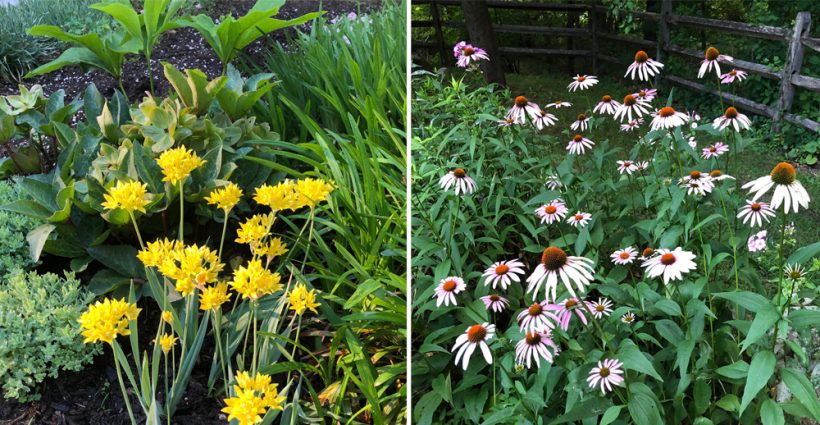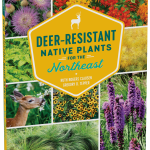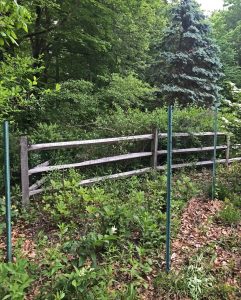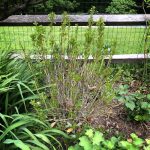designed for the way women work.

Deer-Resistant Native Plants for the Northeast by Ruth Rogers Clausen and Gregory D. Tepper
Category: Presenting "The Curious Gardener"
Horticulturist and author Ruth Rogers Clausen has a new book out, published by Timber Press, titled “Deer-Resistant Native Plants for the Northeast,” co-authored with Gregory D. Tepper. Womanswork is giving away a copy of her new book, which features 75 native plants that deer seldom browse. She gives each plant a deer resistant rating from 7-10. Anything below 7 is considered deer candy and is not included in the book.
To enter, tell us in a Comment below, or via Facebook or Instagram, why you want to win this book. Entries must be submitted by Sunday June 6th.
Here are some highlights Ruth picked out from her book for “Curious Gardener” readers.
- If you co-exist in an area with deer, sooner or later they will probably find your garden and want to use it as a buffet.
- Deer are creatures of habit and return to the same place over and over again for food and to drop their young. If a fawn is born on your property be assured that it will return its whole life to that spot. If you see a pregnant doe, move it along gently beyond your property.
- If food is scarce and deer are stressed by hunger there is no plant that is reliably deer PROOF. Some plants are commonly known as “deer candy”—phlox, daylilies, tulips, hostas, crab apples, trilliums, poison ivy etc.
- Others are considered “deer resistant” of various reliabilities – sages, yarrows, ferns, ornamental grasses and sedges, bush cinquefoil, baptisia etc. The scale of deer browsing ranges from them sometimes nipping off the flowers but ignoring the foliage, as in astilbe, to almost never feeding on the plants at all, as in hellebores.
- However different herds have different palates, and these vary considerably from garden to garden, to different areas, and from year to year. 2020 was a year when the oak trees in particular produced huge crops of acorns, one of the favorite foods for deer.
- In general plants with certain features are less likely to be browsed by deer: fuzzy leaves, tough leathery or fibrous foliage, aromatic flowers and/or leaves, spines or bristles, poisonous compounds.
- Plants grown soft with plenty of fertilizer and water are prime targets for deer.
- Watering from above, especially late in the day, encourages deer to stop by for a meal that night. If it is hot and dry, deer will be thirsty as are we.
- Protect newly planted young trees and shrubs from buck rubbing and browsing until the plants are well established.

Here are some additional lessons I’ve learned as a gardener in deer territory:

In winter food is always scarce so the best protection for evergreen shrubs is to wrap them in burlap or fence in sections of your garden that you want to protect. In the spring after new growth begins and food is more plentiful, you can unwrap those plants. I planted a grouping of 3 oakleaf hydrangeas two years ago and they were eaten pretty well by the deer their first winter, so last fall we put a temporary fence around them and they have nicely leafed out this spring. I think I’m going to leave the fence up for a while longer to be safe. I’ve been told that most shrubs can survive one season of being chomped on by deer, but two seasons can permanently weaken them.
Early in the spring as perennials begin to emerge, try to get the deer who visit your garden out of the habit of grazing by spraying the plants with a deer repellant. Continue to spray every week or so to protect new growth. Deer will often lose interest and no longer view this as a prime feeding area. Deer sometimes get accustomed to a particular deer repellant and it is no longer as effective. So have a few different brands, with different odors and tastes, on hand. Of course deer repellants can’t be used on edibles.
This treatment is necessary for newly planted perennials too. Nurseries will pump their plants with fertilizer to make them look more appealing at point of sale. This sends out a lot of tender new shoots which is more appealing to the deer also.
Dogs can be a deterrent. Send them out to the garden and their scent will deter deer. Sometimes I encourage my dog Daisy to wander among the plants just to get her scent out there.
Recently there was an article by Margaret Roach in the New York Times titled “The Elusive Deer-Proof Garden”. The article focuses more on strategies for deterring deer, than on plants to grow as in Ruth’s book. If you’re a subscriber to the NY Times you can pick up some really good information. Read it here.



We live just off a golf course, and have plenty of deer in the “neighborhood.” Last year, a youngish buck keep visiting around 5pm and I would spy him out my kitchen window while cooking dinner. I took to running out with apron on and broom in had to move him along. The neighbors must have thought I was crazy, but after about 10 days, he stopped walking through. You can train deer!
I’d like this book to help me find more uninteresting native plants to put into my garden so that they are not encouraged to come in in the first place!
I would like to gift this book to my sister who loves flowers and has not been able to have much in her garden because of the deer in her region. She is so jealous of my garden which thrives (no deer munching).
We live in a development outside of City limits, and I have several gardens. Deer find a nice buffet in my gardens and I like deer, but just not eating my plants.
We relocated to Wisconsin, Zone 5, in 2018. I garden 6 acres of lovely deer habitat! Trying to learn all the possibilities is a full plate!
I am interested in your fence around the oakleaf hydrangea. It doesn’t look very tall.
I had a 4 ft. fence around my vegetable garden until the deer jumped over it, browsed at the buffet and jumped back out. The garden isn’t large and it was amazing to me that they could pull this off. I now have a 7 ft. fence and friends tell me it should be 8 ft. We’ll see if it works!
What a beautiful garden! My daughter has a problem with deer in her area this was such a good read I’m passing it on to her now. Thank you
Hello,
I would love to win this book because I am new to gardening and have just started to understand the importance of using native plants. My family moved into a new home in April of late year, and there was no landscaping to speak of, so we have been accumulating as much knowledge as we can as we make selections. One morning last summer (my birthday, in fact), I was startled and amazed to see a mother deer and her two fawns cross our front lawn and disappear into the woodland at the edge of our backyard. It was some time after that sighting that it dawned on me that our new landscaping might be a food source. So there is much to learn as we get settled here and grow into our surroundings, and this book would surely help us make informed decisions. Thanks for you consideration.
Just loved all the hints from Ruth to help keep the deer from meals in our garden. They visit continually as we have great shelter in the nearby woods and a watering hole provided by our pond. They are so bold that they look in the kitchen window and will watch me feed the fish in the pond. They stare at us as we sit on the patio and set off the ring door bell at very in convenient times. A doe and her newborn visited yesterday. I have used various sprays, Deer No No, and all plants yellow to deter my visitors so now would love to be a recipient of Ruth’s book to find more plants that will keep God’s beautiful creatures from dining in my gardens!
Living in PA, seeing deer in my yard is a pleasure.. so is seeing my perennials bloom. Seems I can’t have both though as the deer are nipping everything off! I could really use this book to learn to choose my plants more wisely and save in the pocketbook.
Great article, I’m passing it along to my mother in law and husband’s aunt. They have issues with deer in their beautiful flower gardens in the city. Would love to pass the book on to them as well.
I’m new to gardening where deer are present and I would appreciate the knowledge from an expert on how to coexist with these beautiful creatures and enjoy a healthy garden.
Thanks,
Reg Ford
Jidge@att.net
Thank you for sharing this book with us.
Two deer out back just last night as we ate dinner, looking forward to getting some new ideas! Thanks –
I NEED this book to give to my sister.
Having the Clausen advice on evergreen shrub protection might have saved my boxwoods. After 10 years with no problem, I thought boxwoods were unpalatable. Well….. I think 2 are a total loss.
Wonder what she thinks of the skewers amongst the hosta technique!
Very nice – I live in a completely wooded area and have lots of deer. I even put food out for them to deter them from the plants but they seem to bring their friends and eat everything
Thank you
Always interested in deer resistant plants because I live in Northern Wisconsin which is deer country. They eat everything!
Our Wisconsin house is on a lake and across from a wooded area. A lovely setting for wildlife and the neighboring deer enjoy drinking from the lake. They also enjoy nibbling in both my flower and vegetable beds! This article is very helpful. Thanks for the tips!
We live in rural North Georgia and the deer consider my garden an all you can eat buffet… much to my chagrin.
As a former master gardener I knew some tricks for repelling deer. We inherited and remodeled a house on Lake Huron in Michigan, and use it often. We have deer regularly -14 one day. My trillium is fenced, my common daylily has been shared, and my transplanted special daylilies were chomped. I’m gathering dog hair. But I learned some new hints in the column about the book, and need to read it!
I’d love to win a copy of this book – we have deer in the hills behind our house – they like to eat our fruit tree blossoms, and hostas, and beans!! I’ve tried lots of non-poisonous methods, but they keep coming back.
I am a master gardener volunteer in Florida. I frequently get questions from residents about what to plant that the deer won’t eat. This book could help me help others even though I realize the deer may have different taste preferences here and we have different plants here.
I live in the Midwest and have very bold deer running our suburban streets/yards. A very helpful resource for all gardeners/homeowners who have to deal
with these unwanted guests.
Would love this book to learn how to create the perfect garden for our enjoyment vs theirs!
I’m a Horticulturist by trade for the past 33 years, I just designed a memory garden for my sisters friend who lost her very young daughter to brain cancer. The young lady loved purple and most of the plant material in the garden is purple. I had to do some research for “deer resistant” plant material and to my surprise there is a lot of purple plant material that is “deer resistant”. They are surrounded by woods and their extensive vegetable garden is completely fenced in.
What a great idea to publish a book that gives you a scale for each perennial to share with others for future reference. I work on an estate in Michigan that is open to the public and visitors are always asking what to plant where deer are present. They always want tulips, I say there are many new colors of daffodils that can give you that same spring beauty. 🙂
Oregon residents who love our deer, but find the damage they do distressing. This book sounds like it would provide suggestions on how we can live together.
We are in the process of moving to our dream retirement home in Maine. The yard is now a blank canvas for gardening joys. The owners have told us deer are plentiful on the property. I would love to win this book and use it to create a flower filled deer desert!
We just planted 209 new trees on our new farm. We are regenerating forest, creating a space of beauty (yoga platform and walking mandala) and continuing to farm small pieces of this 40+ year old soy-corn rotation ! 53 acres – oh my. We used Plantskydd around the most yummy saplings but I see the service berries got a nibble yesterday. A few new chicken wire fences to be installed. I love our natives and I think the reason more of them don’t persist is the quite healthy deer population. This book would give me a nudge in the right direction.
We have been trying to outwit deer at our home in CT for 30 years! We finally put up a fence around the immediate perimeter of the house (trying to minimize the tick threat as well), but the property beyond the fence is fair game to all the critters, especially deer. I want to make this part of our property beautiful and inviting, without wasting money, time, and effort (I do all the landscaping myself!).
Fir the first time this year deer ate my holly. I’m hoping it comes back!
This book would help us keep our yard as native and pollinator friendly as possible, with color and variety options as well. Every time we Introduce new plants, the deer come and eat or rip them up, just to see if they are edible. Better planning and a guide will help us obtain a pretty garden with variety.
enter for give away
I’d love to win a copy of this book. We moved from Kailua, HI, to Mattapoisett, MA almost four years ago and every year go through the love/hate cycle with deer. It’s so much fun to see them move through the yard, but then they graze on our hostas, evergreens, azaleas and some lilies. Or maybe I’m confusing their eating habits with rabbits, chipmunks and groundhogs.
Once we have temptations growing in the vegetable garden, they jump the fence. We have raised the fences on each of our raised beds which are also inside a fenced garden area. Fingers crossed that we get to eat more of our own food this year.
Deer love our yard! I don’t mind sharing, but I wish they would leave a little for us. The information in this book would be most helpful.
I would love to win this book. I live in Virginia and I have almost three acres mostly woods surrounded by nearly 900 acres of woods ( which I just pretend are mine ?). I see deer daily and ( knock on wood) only once just two weeks ago did they eat a plant. I garden inside a fenced area but want to make the back area a small garden as well. Have to admit seeing deer absolutely makes my day and I don’t mind if they eat some of my plants. Yesterday saw a mama and her very new twins. Life is good.
I am a master gardener and have never dealt with a deer problem where my garden is on Long Island.
I have started a beautiful garden on my daughters property in Pennsylvania and am struggling with deer!
I chose to make this garden with my daughter and her family as a fun project. It has turned to be a deeper one however, since my daughter who has Crohn’s disease is having her colon removed in two weeks. She also has been diagnosed with PSC, a liver disease which will eventually require a lover transplant.
This garden will be a calming area for her… if I can deter the deer. This book will be my guide.
This book looks amazing! I am always looking for plants that are deer resistant! We have half bare cedars that they found delicious last Winter. Wish I would have known about wrapping them!
I am very interested in this book, as I have been operating a small landscape business of design/installation/maintenance for residents in my area, which has a significant urban whitetail deer population. It has been for the most part, a trial and error process to determine how best to design landscapes that specifically do NOT encourage deer to visit the property. Many shrubs and perennials usually ignored by deer are decimated during certain winters in our area, and it would be helpful to have additional guidance from this text to assist my customers in creating landscapes they love to inhabit and which do not encourage browsing and grazing by the ubiquitous deer. Thank you for organizing this giveaway. It is a great opportunity to create positive publicity for Ruth and Greg’s book.
I love watching the deer in our yard, as we have app. 6-12 of them on a daily basis. But with their daily presence comes their eating many of my perennials! I would love to win this book, as it would definitely be of use to me.
Lots of deer in our wooded surroundings. Would love to win your book.
?
We have a. Daily walk through by the deer.
In trying to build native plant communities on my own property and helping others on their‘s, it is definitely a challenge trying to establish plants amongst the rabbits and deer. We have a very large deer population in our area and trial and error can become expensive and frustrating! Would welcome new information especially regarding native plants!
6 years ago we purchased a 3-acre property in northeast CT. It had fruit trees, a pond, and some landscaping, but I’ve been slowly working to make it less labor-intensive. Part of that plan will be to put in perennials that are deer resistant, as many that were put in before have been ruined by the deer. I would make good use of the information in this book.
Trying to find out what to plant in my woods now that we have cleared out the vines. We have a resident deer herd.
The last time I saw the deer there were 7 at one time. This spring I noticed my rhododendron which is 15 years old is nothing but green sticks where the deer can reach. This Book would make it easier to look for plants
Interesting information. The deer live my plants. Learning how to live with them would be great
I’ve been a native gardener for several years in the NW Ohio Oak Openings area. Deer are part of the landscape in our urban area. I continue to look for resources to advise me on best practices to limit damage and over feeding by our deer population.
This would be a perfect book. New house will be on an area with lots of deer. I want to keep as many of my plants as possible l.
What a beautiful resource this book is! My sweet little dog passed away a couple months ago. She was 17. I didn’t realize that her presence had kept the deer out of my yard. My beautiful flowers and berries are munched regularly now. This book would be valuable to have indeed!
I recently started a garden in a rural section outside of Boston MA. The does and fawns are visiting regularly. We thought it was cute until I read Ruth comments above. Ruth’s book will help me avoid making a ton of mistakes,. I might even be able to stop the deer from returning with Ruth’s help!
I am in northwest Indiana on 20 acres and deal with deer all the time, especially in winter. They ate the creeping phlox at the base of our grandchildren’s’ trees until we covered the plants with wire caging material. This winter the snow was very deep for a time and they ate nearly every ‘leaf’ off all our yews and arborvitae, so now we have see-through evergreens up to about 4 1/2 feet high. Between deer, raccoons, and rabbits, gardening is a real challenge! I must cage every single plant when it is planted for at least six months.